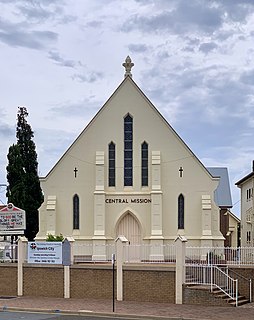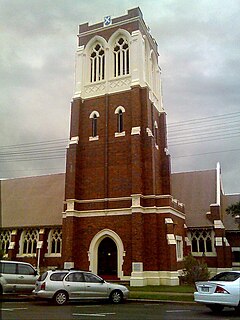
Sinnamon Park is a suburb in the City of Brisbane, Queensland, Australia. In the 2016 census, Sinnamon Park had a population of 6,419 people.

Albert Street Uniting Church is a heritage-listed church at 319 Albert Street, Brisbane City, City of Brisbane, Queensland, Australia. It was designed by George Henry Male Addison and built from 1888 to 1889 by Thomas Pearson & Sons. It was originally known as Albert Street Methodist Church and Central Methodist Mission. It was added to the Queensland Heritage Register on 21 October 1992.

Christ Church is a heritage-listed Anglican church at 3 Chippendall Street, Milton, City of Brisbane, Queensland, Australia. The current church building is the second one at this site and was designed by John H Buckeridge and built in 1891 as a "temporary" structure but remains in use to this day. The rectory was built in 1883 to a design of F.D.G. Stanley. It is also known as the former Memorial Church. It was added to the Queensland Heritage Register on 21 October 1992.

Wesley Uniting Church is a heritage-listed former church at 54 Neil Street, Toowoomba, Toowoomba Region, Queensland, Australia. It was designed by Willoughby Powell and built from 1877 to 1924. It is also known as Wesleyan Methodist Church. It was added to the Queensland Heritage Register on 10 May 1997.

All Saints Memorial Church is a heritage-listed Anglican church at Tamrookum Church Road, Tamrookum, Scenic Rim Region, Queensland, Australia. It was designed by Robin Dods and built in 1915. It was added to the Queensland Heritage Register on 21 October 1992.

The Mowbraytown Presbyterian Church is a heritage-listed church precinct at 22-28 Mowbray Terrace, East Brisbane, City of Brisbane, Queensland, Australia. It was designed by architect Alexander Brown Wilson and built from 1885 to c. 1916. It is also known as East Brisbane Presbyterian Church. It was added to the Queensland Heritage Register on 22 October 1993.

Hemmant Christian Community Church is a heritage-listed church at 69 Hemmant Road, Hemmant, City of Brisbane, Queensland, Australia. It was built from 1865 to 1866. It is also known as Hemmant Methodist Church, Hemmant Uniting Church, and Tingalpa Wesleyan Methodist Church. It was added to the Queensland Heritage Register on 21 October 1992.

Christ Church Tingalpa and Burial Ground is a heritage-listed former Anglican church at 1341 Wynnum Road, Tingalpa, City of Brisbane, Queensland, Australia. It was built from 1868 to 1993. It is now known as the Pioneer Wedding Chapel. It was added to the Queensland Heritage Register on 2 February 1998.

Sinnamon Farm is a heritage-listed farm at 645 & 693 Seventeen Mile Rocks Road, Sinnamon Park, City of Brisbane, Queensland, Australia. It was built from 1869 to 1890s. It is also known as Avondale & Macleod aviation site, Beechwood, Glen Ross, and Seventeen Mile Rocks School. It was added to the Queensland Heritage Register on 21 October 1992.

St John's Church is a heritage-listed Anglican church at Mundoolun Road, Mundoolun, City of Logan, Queensland, Australia. It was designed by John Hingeston Buckeridge and built from 1901 to 1915. It is also known as Memorial Church of St John the Evangelist. It was added to the Queensland Heritage Register on 26 November 1999.

St Pauls Anglican Church is a heritage-listed church at Cross Street, Cleveland, City of Redland, Queensland, Australia. It was designed by James Furnival and built in 1873; it was extended in 1924 to a design by Lange Leopold Powell. It was added to the Queensland Heritage Register on 21 October 1992.

St Andrews Church is a heritage-listed Anglican church at Wellington Street, Ormiston, City of Redland, Queensland, Australia. It was built c. 1868. It was added to the Queensland Heritage Register on 21 October 1992.

St Davids Anglican Church is a heritage-listed church at 1 Church Street, Allora, Southern Downs Region, Queensland, Australia. It was designed by Francis Drummond Greville Stanley and built from 1887 to 1901. It is also known as St David's Church of England. It was added to the Queensland Heritage Register on 24 March 2000.

St Augustines Anglican Church is a heritage-listed church at Dove Street, Leyburn, Southern Downs Region, Queensland, Australia. It was designed by Richard George Suter and built from 1871 to 1918. It is also known as St Augustine's Church of England. It was added to the Queensland Heritage Register on 21 August 1992.

Warwick Uniting Church is a heritage-listed church at 37 Guy Street, Warwick, Southern Downs Region, Queensland, Australia. It was built from 1869 to 1922. It is also known as St Andrews Presbyterian Church. It was added to the Queensland Heritage Register on 24 March 2000.

St Paul's Anglican Church is a heritage-listed church at 124 Brisbane Street, Ipswich, City of Ipswich, Queensland, Australia. It was built from 1855 to 1929. It was added to the Queensland Heritage Register on 21 October 1992.

Ipswich Central Mission is a heritage-listed Uniting church at Ellenborough Street, Ipswich, City of Ipswich, Queensland, Australia. It was designed by Samuel Shenton and built in 1858 by Samuel Shenton. It is also known as Wesleyan Chapel, Ellenborough Street Church, and Ipswich City Uniting Church. It was added to the Queensland Heritage Register on 21 October 1992.

North Pine Presbyterian Church is a heritage-listed church at Dayboro Road, Kurwongbah, Moreton Bay Region, Queensland, Australia. It was built from 1883 to 1884. It was added to the Queensland Heritage Register on 21 October 1992.

St Andrews Uniting Church is a heritage-listed church at the corner of Maryborough and Woongarra Streets, Bundaberg Central, Bundaberg, Bundaberg Region, Queensland, Australia. It was designed by Lange Leopold Powell and built from 1931 to c. 1940. It was added to the Queensland Heritage Register on 3 August 2004.

St Pauls Uniting Church is a heritage-listed church at 21 MacAlister Street, Mackay, Mackay Region, Queensland, Australia. It was designed by Walter Carey Voller and built from 1898 to 1918. It is also known as St Pauls Presbyterian Church. It was added to the Queensland Heritage Register on 21 August 1992.





















